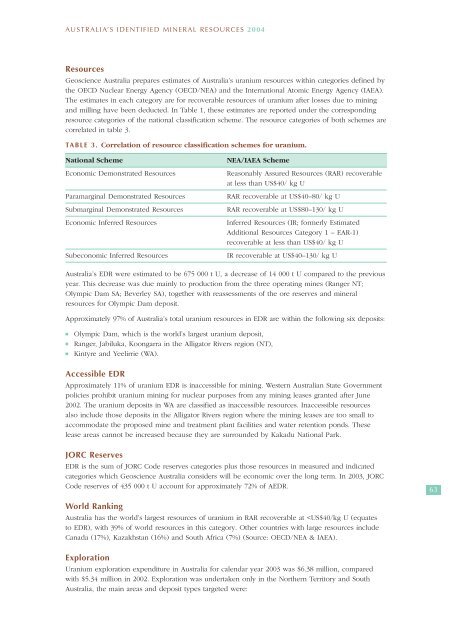australia's identified mineral resources 2004 - Geoscience Australia
australia's identified mineral resources 2004 - Geoscience Australia
australia's identified mineral resources 2004 - Geoscience Australia
You also want an ePaper? Increase the reach of your titles
YUMPU automatically turns print PDFs into web optimized ePapers that Google loves.
AUSTRALIA’S IDENTIFIED MINERAL RESOURCES <strong>2004</strong><br />
Resources<br />
<strong>Geoscience</strong> <strong>Australia</strong> prepares estimates of <strong>Australia</strong>’s uranium <strong>resources</strong> within categories defined by<br />
the OECD Nuclear Energy Agency (OECD/NEA) and the International Atomic Energy Agency (IAEA).<br />
The estimates in each category are for recoverable <strong>resources</strong> of uranium after losses due to mining<br />
and milling have been deducted. In Table 1, these estimates are reported under the corresponding<br />
resource categories of the national classification scheme. The resource categories of both schemes are<br />
correlated in table 3.<br />
TABLE 3. Correlation of resource classification schemes for uranium.<br />
National Scheme<br />
Economic Demonstrated Resources<br />
Paramarginal Demonstrated Resources<br />
Submarginal Demonstrated Resources<br />
Economic Inferred Resources<br />
Subeconomic Inferred Resources<br />
NEA/IAEA Scheme<br />
Reasonably Assured Resources (RAR) recoverable<br />
at less than US$40/ kg U<br />
RAR recoverable at US$40–80/ kg U<br />
RAR recoverable at US$80–130/ kg U<br />
Inferred Resources (IR; formerly Estimated<br />
Additional Resources Category 1 – EAR-1)<br />
recoverable at less than US$40/ kg U<br />
IR recoverable at US$40–130/ kg U<br />
<strong>Australia</strong>’s EDR were estimated to be 675 000 t U, a decrease of 14 000 t U compared to the previous<br />
year. This decrease was due mainly to production from the three operating mines (Ranger NT;<br />
Olympic Dam SA; Beverley SA), together with reassessments of the ore reserves and <strong>mineral</strong><br />
<strong>resources</strong> for Olympic Dam deposit.<br />
Approximately 97% of <strong>Australia</strong>’s total uranium <strong>resources</strong> in EDR are within the following six deposits:<br />
■<br />
■<br />
■<br />
Olympic Dam, which is the world’s largest uranium deposit,<br />
Ranger, Jabiluka, Koongarra in the Alligator Rivers region (NT),<br />
Kintyre and Yeelirrie (WA).<br />
Accessible EDR<br />
Approximately 11% of uranium EDR is inaccessible for mining. Western <strong>Australia</strong>n State Government<br />
policies prohibit uranium mining for nuclear purposes from any mining leases granted after June<br />
2002. The uranium deposits in WA are classified as inaccessible <strong>resources</strong>. Inaccessible <strong>resources</strong><br />
also include those deposits in the Alligator Rivers region where the mining leases are too small to<br />
accommodate the proposed mine and treatment plant facilities and water retention ponds. These<br />
lease areas cannot be increased because they are surrounded by Kakadu National Park.<br />
JORC Reserves<br />
EDR is the sum of JORC Code reserves categories plus those <strong>resources</strong> in measured and indicated<br />
categories which <strong>Geoscience</strong> <strong>Australia</strong> considers will be economic over the long term. In 2003, JORC<br />
Code reserves of 435 000 t U account for approximately 72% of AEDR.<br />
63<br />
World Ranking<br />
<strong>Australia</strong> has the world’s largest <strong>resources</strong> of uranium in RAR recoverable at

















